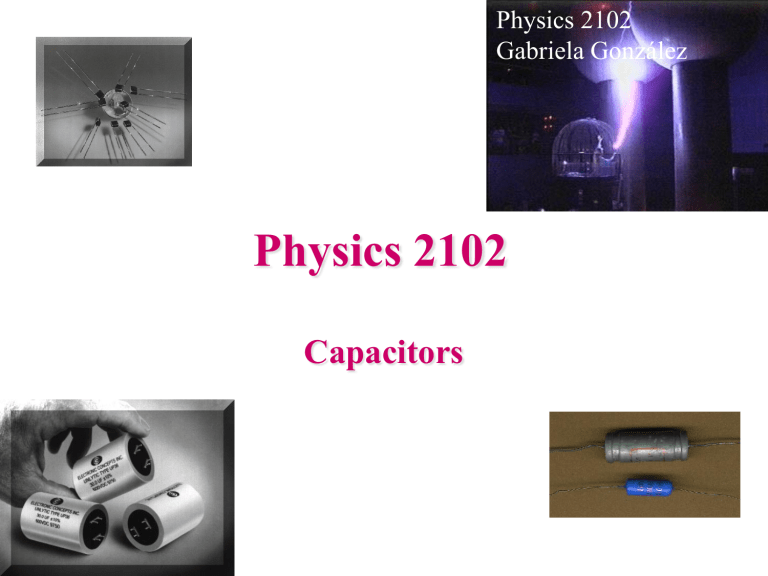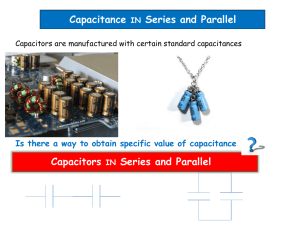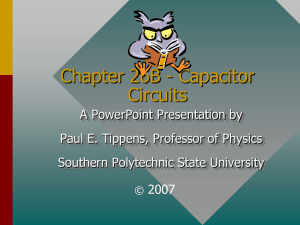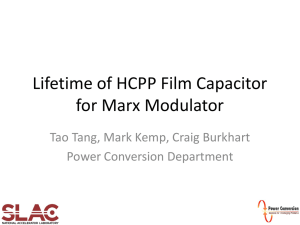pptx
advertisement

Physics 2102 Gabriela González Physics 2102 Capacitors Capacitors and Capacitance Capacitor: any two conductors, one with charge +Q, other with charge -Q -Q Potential DIFFERENCE between +Q Uses: storing and releasing conductors = V Q = CV -- C = capacitance Units of capacitance: Farad (F) = Coulomb/Volt electric charge/energy. Most electronic capacitors: micro-Farads (mF), pico-Farads (pF) -- 10-12 F New technology: compact 1 F capacitors Capacitance • Capacitance depends only on GEOMETRICAL factors and on the MATERIAL that separates the two +Q conductors -Q • e.g. Area of conductors, separation, whether the space in between is filled (We first focus on capacitors with air, plastic, etc. where gap is filled by AIR!) Electrolytic (1940-70) Electrolytic (new) Paper (1940-70) Capacitors Variable air, mica Tantalum (1980 on) Ceramic (1930 on) Mica (1930-50 Capacitors and Capacitance Capacitor: any two conductors, one with charge +Q, other with charge -Q +Q -Q Potential DIFFERENCE between Uses: storing and releasing conductors = V Q = CV C = capacitance Units of capacitance: Farad (F) = Coulomb/Volt electric charge/energy. Most electronic capacitors: micro-Farads (mF), pico-Farads (pF) -- 10-12 F New technology: compact 1 F capacitors Parallel Plate Capacitor We want capacitance: C=Q/V E field between the plates: (Gauss’ Law) s Q E 0 0 A Area of each plate = A Separation = d charge/area = s= Q/A Relate E to potential difference V: d Q Qd V E dx dx A 0 A 0 0 0 d What is the capacitance C? Q 0 A C V d +Q -Q Parallel Plate Capacitor -- example • A huge parallel plate capacitor consists of two square metal plates of side 50 cm, separated by an air gap of 1 mm • What is the capacitance? • C = 0A/d = (8.85 x 10-12 F/m)(0.25 m2)/(0.001 m) = 2.21 x 10-9 F (small!!) Lesson: difficult to get large values of capacitance without special tricks! Isolated Parallel Plate Capacitor Q Q 0 A C V Ed d • A parallel plate capacitor of capacitance C is charged using a +Q battery. • Charge = Q, potential difference = V. • Battery is then disconnected. • If the plate separation is INCREASED, does potential difference V: (a) Increase? • Q is fixed! (b) Remain the same? • C decreases (=0A/d) (c) Decrease? • Q=CV; V increases. -Q Parallel Plate Capacitor & Battery Q Q 0 A C V Ed d • A parallel plate capacitor of capacitance C is charged using a battery. = V. • Charge = Q, potential difference • Plate separation is INCREASED while battery remains connected. Does the electric field inside: (a) Increase? (b) Remain the same? (c) Decrease? • V is fixed by battery! • C decreases (=0A/d) • Q=CV; Q decreases • E = Q/ 0A decreases +Q -Q Spherical Capacitor What is the electric field inside the capacitor? (Gauss’ Law) E Radius of outer plate = b Radius of inner plate = a Q 40 r 2 Relate E to potential difference between the plates: b b Concentric spherical shells: Charge +Q on inner shell, -Q on outer shell b kQ kQ V E dr 2 dr - r r a a a 1 1 kQ - a b Spherical Capacitor What is the capacitance? C = Q/V = Q Q 1 1 - 40 a b 40 ab (b - a) Radius of outer plate = b Radius of inner plate = a Concentric spherical shells: Charge +Q on inner shell, -Q on outer shell Isolated sphere: let b >> a, C 40 a Cylindrical Capacitor What is the electric field in between the plates? E Radius of outer plate = b Radius of inner plate = a Length of capacitor = L +Q on inner rod, -Q on outer shell Q 2 0 rL Relate E to potential difference between the plates: V E dr cylindrical surface of radius r b b Q ln r Q b dr ln 20 rL 20 L a 20 L a a b a Q Cylindrical Capacitor What is the capacitance C? C = Q/V = Q b ln 20 L a 20 L b ln a Q Radius of outer plate = b Radius of inner plate = a Length of capacitor = L Charge +Q on inner rod, -Q on outer shell Example: co-axial cable. Summary • Any two charged conductors form a capacitor. •Capacitance : C= Q/V •Simple Capacitors: Parallel plates: C = 0 A/d Spherical : C = 4 0 ab/(b-a) Cylindrical: C = 2 0 L/ln(b/a) Capacitors in Parallel • A wire is a conductor, so it is an equipotential. • Capacitors in parallel have SAME potential difference but NOT ALWAYS same charge. • VAB = VCD = V • Qtotal = Q1 + Q2 • CeqV = C1V + C2V • Ceq = C1 + C2 • Equivalent parallel capacitance = sum of capacitances PARALLEL: • V is same for all capacitors • Total charge in Ceq = sum of charges A C Q1 C1 Q2 C2 Qtotal B D Ceq Capacitors in series • Q1 = Q2 = Q (WHY??) • VAC = VAB + VBC Q1 Q2 B A Q Q Q Ceq C1 C2 1 1 1 Ceq C1 C2 SERIES: • Q is same for all capacitors • Total potential difference in Ceq = sum of V C1 C C2 Q Ceq Capacitors in parallel and in series • In parallel : – Ceq = C1 + C2 – Veq=V1=V2 – Qeq=Q1+Q2 C1 Q1 Qeq C2 Q2 Ceq • In series : – 1/Ceq = 1/C1 + 1/C2 – Veq=V1 +V2 – Qeq=Q1=Q2 Q1 Q2 C1 C2 Example 1 What is the charge on each capacitor? • Q = CV; V = 120 V • Q1 = (10 mF)(120V) = 1200 mC • Q2 = (20 mF)(120V) = 2400 mC • Q3 = (30 mF)(120V) = 3600 mC Note that: • Total charge (7200 mC) is shared between the 3 capacitors in the ratio C1:C2:C3 -- i.e. 1:2:3 10 mF 20 mF 30 mF 120V Example 2 What is the potential difference across each capacitor? • Q = CV; Q is same for all capacitors • Combined C is given by: 10 mF 20 mF 30 mF 1 1 1 1 Ceq (10mF ) (20mF ) (30mF ) 120V • Ceq = 5.46 mF • Q = CV = (5.46 mF)(120V) = 655 mC • V1= Q/C1 = (655 mC)/(10 mF) = 65.5 V Note: 120V is shared in the • V2= Q/C2 = (655 mC)/(20 mF) = 32.75 V ratio of INVERSE capacitances • V3= Q/C3 = (655 mC)/(30 mF) = 21.8 V i.e.1:(1/2):(1/3) (largest C gets smallest V) Example 3 10 mF In the circuit shown, what is the charge on the 10mF capacitor? 5 mF • The two 5mF capacitors are in parallel • Replace by 10mF • Then, we have two 10mF capacitors in series • So, there is 5V across the 10mF capacitor of interest • Hence, Q = (10mF )(5V) = 50mC 5 mF 10V 10 mF 10 mF 10V Energy Stored in a Capacitor • Start out with uncharged capacitor • Transfer small amount of charge dq from one plate to the other until charge on each plate has magnitude Q • How much work was needed? Q Q dq 2 q Q CV U Vdq dq C 2C 2 0 0 2 Energy Stored in Electric Field • Energy stored in capacitor:U = Q2/(2C) = CV2/2 • View the energy as stored in ELECTRIC FIELD • For example, parallel plate capacitor: Energy DENSITY = energy/volume = u = 2 Q Q 0 Q 0E 2 Q U 2 2CAd 2 0 A Ad 2 0 A 2 A 2 0 2 2 2 d volume = Ad General expression for any region with vacuum (or air) Example • 10mF capacitor is initially charged to 120V. 20mF capacitor is initially uncharged. • Switch is closed, equilibrium is reached. • How much energy is dissipated in the process? 10mF (C1) Initial charge on 10mF = (10mF)(120V)= 1200mC 20mF (C2) After switch is closed, let charges = Q1 and Q2. Charge is conserved: Q1 + Q2 = 1200mC • Q1 = 400mC Q2 Also, Vfinal is same: Q1 Q2 • Q2 = 800mC Q1 C1 C 2 2 • Vfinal= Q1/C1 = 40 V Initial energy stored = (1/2)C1Vinitial2 = (0.5)(10mF)(120)2 = 72mJ Final energy stored = (1/2)(C1 + C2)Vfinal2 = (0.5)(30mF)(40)2 = 24mJ Energy lost (dissipated) = 48mJ Dielectric Constant DIELECTRIC +Q - Q C = A/d • If the space between capacitor plates is filled by a dielectric, the capacitance INCREASES by a factor • This is a useful, working definition for dielectric constant. • Typical values of : 10 - 200 Example • Capacitor has charge Q, voltage V • Battery remains connected while dielectric slab is inserted. • Do the following increase, decrease or stay the same: – Potential difference? – Capacitance? – Charge? – Electric field? dielectric slab Example (soln) • Initial values: capacitance = C; charge = Q; potential difference = V; electric field = E; • Battery remains connected • V is FIXED; Vnew = V (same) • Cnew = C (increases) • Qnew = (C)V = Q (increases). • Since Vnew = V, Enew = E (same) dielectric slab Energy stored? u=0E2/2 => u=0E2/2 = E2/2 Summary • Capacitors in series and in parallel: • in series: charge is the same, potential adds, equivalent capacitance is given by 1/C=1/C1+1/C2 • in parallel: charge adds, potential is the same, equivalent capaciatnce is given by C=C1+C2. • Energy in a capacitor: U=Q2/2C=CV2/2; energy density u=0E2/2 • Capacitor with a dielectric: capacitance increases C’=C


![Sample_hold[1]](http://s2.studylib.net/store/data/005360237_1-66a09447be9ffd6ace4f3f67c2fef5c7-300x300.png)


